
Articles

14
Images
To flip through all the images with
this article click on the camera to begin.
When you want to see the next image, click anywhere on the current
image.
|
|
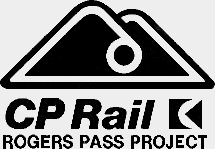 Back in 1984 CP Rail, as the Canadian Pacific Railway was then
known, had started construction on the Rogers Pass Project. To help explain the
tremendous amount of work and cost involved CP Rail prepared a folder containing
several press releases including a few photos of the project as it was then taking
shape. Most of those releases are recorded here, and for historical sake, still
make interesting reading today. Please carry on... Back in 1984 CP Rail, as the Canadian Pacific Railway was then
known, had started construction on the Rogers Pass Project. To help explain the
tremendous amount of work and cost involved CP Rail prepared a folder containing
several press releases including a few photos of the project as it was then taking
shape. Most of those releases are recorded here, and for historical sake, still
make interesting reading today. Please carry on...
Canadian Pacific and Rogers Pass
When Canadian Pacific was founded in 1881, its charter provided that the main line
would cross the Rocky Mountains by way of Yellowhead Pass, the route now used by
Canadian National. This pass had been selected by Sandford Fleming during surveys
in the 1870s, when the federal government had planned to build the Pacific railway
as a public work.
| |
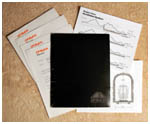
Rogers Pass Project press release
folder prepared by CP Rail in 1984.
|
When the project was transferred to private hands with the incorporation of what
now is Canadian Pacific, business and commercial questions became involved in the
route selection, and the company's founders felt it imperative that a more direct
route should be found through the British Columbia mountains.
Accordingly, in the spring of 1881, Canadian Pacific hired Major Albert
Bowman Rogers, an American military-turned-civil
engineer to find such a route.
Viable, more direct routes through the rocky Mountains existed, such as the
Kananaskis, Kicking Horse, and Howse passes. The problem of location was centered
on the Selkirk Range, the next range west of the Rockies, which seemed to pose an
impenetrable barrier to the railway's location engineers.
As soon as he was hired, Major Rogers decided to approach the Selkirks from the
west, rather than the east. He and his party proceeded up the Columbia River to the
site of what now is Revelstoke, where they turned eastward into the valley of the
Illecillewaet River, ascending that stream for about 35 miles (50 kilometres) until
it appeared to terminate at the foot of the Illecillewaet Glacier, the "Great
Glacier of the Selkirks".
Rogers and his party climbed some of the peaks to obtain a better perspective, and
on 29 May 1881, he located the pass which would subsequently bear his
name. In the season of 1882, he found the eastern approach to the pass by way of
the valley of the Beaver River.
Canadian Pacific recognized Rogers' contribution by awarding him $5,000 and a gold
pocket watch, and Rogers Pass entered the nomenclature of Canadian place names.
The construction railhead, advancing from the east, reached the foot of the
Selkirks at Beavermouth at the end of the construction season of 1884. The laying
of rails through the Selkirks and up to a connection with the construction
advancing from the west, in Eagle Pass, occupied the whole of 1885.
The location up the east slope of the Selkirks by way of the Beaver Valley required
a 21-mile (33 kilometre) railway line which was reasonably straight,
and overcame a vertical distance of 1,907 feet (581 metres), an average of 90.8
feet per mile (17 metres/kilometre) or 1.7 percent. There were short stretches on
this approach which were inclined at 2.5 percent, however. In the pass itself, the
railway attained an altitude of 4,340 feet (1,323 metres).
The descent of the western slope of the Selkirks was quite a different matter. The
access valley descended far too rapidly for parallel railway location: more
than 1,200 feet (366 metres) in less than three miles (4.8 kilometres). To maintain
the target maximum 2.2 percent grade, the railway had to be located around three loops
situated, respectively, in the valleys of Glacier Creek, Loop Creek, and the
Illecillewaet River, to gain the necessary mileage. The 10 miles (16 kilometres) of
railway line this achieved had an average grade of 96 feet to the mile
(18 metres/kilometre) or 1.8 percent.
As if this sinuous course did not present enough difficulties, the line in the pass
encountered a belt of heavy annual snowfalls, up to 500 inches (1,270 centimetres).
This snowfall was caused by the action of warm air currents from the Pacific
striking the cold Selkirk peaks, the first major mountain barrier east of the
Pacific Ocean. The snow complicated winter train operation, not only when avalanches
occurred, but also in the day-to-day routine of keeping the
single-track railway clear for train traffic.
While the rails were put down through the Selkirks in the season of 1885 - and
through Rogers Pass itself in August of that year - the completion of the whole
transcontinental line with the driving of the last spike in Eagle Pass on
7 November 1885, left the season too far advanced for the task of
completing the line.
An observation party, in charge of Chief Engineer G.C. Cunningham, was left in
Rogers Pass for the winter of 1885-86, to make observations of snowfall
and avalanche paths. The resulting report enabled Canadian Pacific, in the spring
of 1886 to begin the construction of the necessary snowsheds to cover critical
parts of the line between Bear Creek, at the eastern entrance to the pass, and
Summit Lake in Eagle Pass. The majority of these 31 snowsheds
were concentrated in the 15 miles of track between Bear Creek and Ross Peak
stations. The aggregate length of these structures, built of wooden timbers to
eight different designs, totalled about 5 miles (8 kilometres).
Where the rails, descending westward from Rogers Pass, entered the first loop at
Glacier Creek, within a short distance from the foot of the Great Illecillewaet
Glacier, Canadian Pacific began construction of a hotel in the autumn of 1886. This
work was stimulated by the establishment, in that year and by the federal
government, of Glacier National Park, an 821 square mile (1,350 square kilometre)
natural wilderness. Opened in 1887, the Glacier Hotel
was the pioneer hostelry in the Selkirks, enabling passengers to disembark from the
transcontinental trains and enjoy a stay in this mountain wilderness.
The railway authorities, conscious of the publicity value of the view of the Glacier
as westbound trains descended from the pass, had a "summer track"
constructed on the outside of several of the snow sheds, so that train movements in
summer avoided the snow sheds at these locations. As soon as the first snow fell in
the autumn, a simple replacement of a few rails at each end of the section routed
the trains through snowsheds for the winter. The Glacier Hotel remained open to the
public until 1925, nine years after the railway itself had been diverted through the
new Connaught
Tunnel.
The consistent grade through the pass posed its own problems. A small railway yard
and engine terminal were located at Rogers Pass summit, which was the operating
base from which powerful pusher steam locomotives assisted trains up both slopes to
the pass. These helper locomotives usually operated between Beavermouth, on the
east, and Revelstoke on the west. The men who manned the station, shops, and
locomotives, and their families, made up a small but hardy permanent community
around the station, which was located about 2 miles (3.2 kilometres) east of the
actual summit.
The station and yard remained at this location for 13 winters, until
31 January 1899, when a snow slide destroyed the railway station and
killed seven people; two telegraph operators, an engine wiper, a cook, and a woman
with two children. Instructions were given immediately to locate a new and safer
site for the station and yard, and a position about one mile nearer the summit was
selected. Work began in the summer of 1899, and the new facilities replaced the old
ones early in 1900. Here, a larger yard was constructed in more secure surroundings.
Ten years later, the railway suffered its worst disaster in the 30-year
occupation of Rogers Pass. During the day of 4 March 1910, a large crew
of men was sent to clear an avalanche which had blocked the main line at Seventeen
Shed, about one mile west of Rogers Pass station. Near midnight, as the men still
worked, a second slide came down from the opposite side of the valley, burying the
gang alive. Sixty-two men died
in this disaster. The next morning, Vancouver-bound Train No. 97, with
400 passengers on board, arrived from the east, to be held until the line at Seventeen
Shed had been cleared. While it was waiting, another large avalanche came down at
Sixteen Shed, about 1.5 miles (2.4 kilometres) east of Rogers Pass, this blocking the
line in both directions.
Even as these events were occurring, an alternative route was in the offing. During
the first decade of the 20th Century, the first capacity crisis was facing the
railway main line. The response to permit freeing the flow of relatively frequent,
comparatively short freight trains by present-day standards, was to
double track the main line from coast to coast.
A start on this program saw the main line between what now is Thunder Bay, Ontario,
and Winnipeg converted to double track operation between 1906 and 1909. Other
sections, in northern Ontario and on the Prairies, followed. When plans began to be
formulated for this program in the mountain areas, Rogers Pass presented a problem,
especially the western slope and the "loops" needed to gain access to the
summit. Double-tracking the loops was impracticable, and the engineers
reached the conclusion that a double-trackedtunnel, which would avoid
the pass area entirely, was necessary. The tunnel which was decided upon would
eliminate curvature equal to seven complete circles, shorten the line by 4.3 miles
(6.9 kilometres) and lower the summit by 551 feet (168 metres). An added bonus would
be the elimination of the need for snowsheds along the abandoned line.
Construction of what was originally known as Selkirk Tunnel, but which was
officially opened as the Connaught Tunnel, started in August, 1913. Just slightly
more than five miles long, the excavation was expedited by the construction of a
small "pioneer" tunnel parallel to the main bore. At periodical intervals,
a short connecting tunnel was cut to the centre line of the main tunnel. Using this
method, excavation of the main line tunnel could go on from a number of faces at
once, the spoil being removed through the pioneer tunnel.
The main tunnel was constructed to accommodate double track. Construction proceeded
quickly, and the first train passed through the Connaught Tunnel on
9 December 1916. Due to the priorities of the First World War, a halt
was called to further work on the double-tracking program until the
close of hostilities. In fact, the 5.4 mile (8.7 kilometre) double track, which ran
through the Connaught Tunnel from Connaught station on the east, to Glacier at the west end was never extended.
The introduction of higher capacity steel railway cars and much heavier and more
powerful locomotives - allowing more tonnage per train - eliminated the need for
the double track program. In fact, in many areas of the system the double track was
taken up in the 1930s, and the rapid movement of trains in both directions over
single track was expedited by the use of Automatic Block Signals and later
Centralized Traffic Control.
The system met the capacity demand of the Second World War era. By the early 1950s,
a radical technological change - the conversion of motive power from steam to
diesel-electric - once again came to the rescue by enabling longer, and
hence fewer, trains on main lines. The double track in the Connaught Tunnel itself
was removed in 1959, and the single track positioned in the centre of the bore,
allowing higher clearances for the new specialized piggyback, container, and auto
carrier cars which were then being introduced.
In 1956, four decades after the railway had been abandoned in Rogers Pass, the
decision was made to reactivate the area for public travel as part of the
Trans-Canada Highway system, which had been authorized by an Act passed
by the federal government in 1949.
When the Highway was completed in 1962, the last section was that through Rogers
Pass. A monument at the summit of the Pass commemorates this event on
3 September 1962, at which Prime Minister John G. Diefenbaker
officiated, and which was otherwise marked by an official motorcade which travelled
across Canada from St. John's, Newfoundland, to Victoria.
The avalanche hazard has persisted, and as a result, five large concrete snowsheds,
with a combined length of 4,964 feet (1,513 metres) have been build over the
highway at known avalanche paths, along with lesser works in the form of earth
dikes and dams on the mountain side which deflect the snowslides over the sheds.
Finally, the Canadian Armed Forces play a role by using mortar fire from
predetermined concrete pads, to start smaller, controlled avalanches and thus
eliminate the larger, potentially-disastrous ones. In spite of these
measures, the highway through Rogers Pass is still blocked occasionally.
An ever-increasinggrain crop, the addition of new bulk commodities such
as potash and sulphur, and the conclusion of contracts with Japan which would
necessitate the uninterrupted movement, on a regular year-round
schedule, of millions of tons of coal from the Crowsnest Pass area to a new
superport at Roberts Bank south of Vancouver, forced new studies to be undertaken in
the late 1960s, to increase line capacity.
Since the preponderance of tonnage was westbound, to the Pacific Coast, attention
was given to double-tracking the line in areas where long grades were
against westbound trains. Another technology examined at this time was the
electrification of the whole main line between Calgary and Vancouver, as well as the
secondary main line from the Crowsnest coal area to Golden. While the conclusion
reached by these studies that electrification was desirable, the enormous capital
costs associated with the project would take decades to amortize, and the decision
was made to postpone this project.
However, all new construction and renovation work allows sufficient clearance for
the overhead electrical catenary - wiring system - to provide for the possible
future electrification of the main line.
Meanwhile main line capacity expansion was continued. In the 1970s four major bottle
necks were identified on the Calgary-Vancouver main line. At each
bottleneck, grades of more than one percent necessitated smaller trains or pusher
locomotives to assist trains over these heavy grade sections. By 1979 the projects
at Salmon Arm and Revelstoke were complete and that at Lake Louise was completed in
1981. In each case, a second main line track was constructed to a maximum grade of
one percent. The existing track continues to be used for eastbound trains while all
heavy westbound traffic moves on the new track.
The most restrictive remaining capacity bottleneck is Rogers Pass. Here a westbound
grade of more than two percent at present requires the addition of as many as six pusher
locomotives to westbound freight trains. The tunnelling and
double-track project planned for Rogers Pass is the single largest
project since the transcontinental main line was completed in 1885.
The financial obstacle to construction of the Rogers Pass project was removed in
late 1983 with the passage of the new Western Grain Transportation Act. The new
legislation eliminates the long-standing railway losses from
transporting grain and makes it possible for CP Rail to raise the additional capital
required for the $600-million-plus construction project.
The long planned double tracking in the
Selkirks, which will involve two new tunnels, one of them 9.11 miles
(14.58 kilometres) in length. The approach grade for westbound trains on the east
slope of the Selkirks will be reduced to one percent from the existing 2.2 percent
average on the steepest of that line. Work on the approach grades has already begun
with construction of the long tunnel (the Macdonald Tunnel) beginning in 1984. The
new track is expected to be in use in 1988. Finishing work, including environmental
rehabilitation will continue in 1989 and beyond as required.
The John Fox Viaduct
CP Rail will build six bridges having a total length of 5,491 feet (1,674
metres) and four major culverts as part of the railway's $600-million
Rogers Pass grade reduction and tunnel project.
The largest bridge project involves construction of a 4,032 foot (1,229 metre) elevated bridge
deck, (the John Fox Viaduct) which will cross an area of extremely
steep slopes near Stoney Creek just west of the east gate of Glacier National Park.
John Fox, vice-president, engineering special projects, says the
elevated structure was selected over conventional
"cut-and-fill" methods for both environmental and economic
reasons.
"The existing slopes in the area are about 41 degrees. If we had used
cut-and-fill methods, extremely long and high retaining walls would be
required - in effect, to support the mountainside", Mr. Fox said. "By
going the elevated structure route, we determined our costs would be cut in half
and there would be substantially less environmental impact".
Culverts will be constructed at Alder, Cedar, Raspberry, and Surprise Creeks.
Rogers Pass Tunnels
31 January 1984 - CP Rail has requested proposals from contractors
for construction of a 9 mile (14.5 kilometre) tunnel under Rogers Pass in British
Columbia's Selkirk Mountains, it was announced today.
"We expect to receive proposals from about 12 tenderers representing some 30
companies", said John Fox, CP Rail vice-president, engineering,
special projects. "In addition, later this year tenders will be called and
contracts awarded for excavation of a 1 mile (1.8 kilometre) tunnel, construction
of six bridges, grading of the 11 mile (17.1 kilometre) surface route, and site
preparation and excavation of a ventilation shaft to the long tunnel".
Those tendering are to submit their bids by the end of March. Contracts will be
awarded by the end of April with a view to starting construction by
1 July 1984.
The tunnel is part of a $600-million project to reduce to one percent
the existing 2.2 percent average grade from the Beaver River Valley to Rogers Pass.
The grade reduction is necessary to provide increased main line capacity required
by 1990 to meet projected traffic demands between Calgary and Vancouver.
In the planning stage since 1972, the Rogers pass project is the biggest single
project undertaken by CP Rail since driving the last spike in the transcontinental
line in 1885.
The 1984 work program was triggered by the new Western Grain Transportation Act
which puts railway grain traffic on a paying basis for the first time in decades.
It will take until the end of 1988 to complete the project, which will create
construction employment measured in the thousands of man-years.
CP Rail will establish two 400-person work camps to accommodate
construction workers employed on the tunnel portion of the project. One will be
located in the Beaver River area near the east portal of the long tunnel, the other
in the Flat Creek area near the west portal. Both camps are within the borders of
Glacier National Park.
West portal 1
- West portal 2
- West portal 3
Provision is being made for a third camp near Rogers siding, outside the National
Park, to accommodate those working on the surface route.
Construction of the tunnel will be carried out from both ends. Designed to carry
westbound trains, the tunnel will head in a southwesterly direction from the east
portal through Mount Macdonald. It will pass 358 feet (109 metres) below the
existing Connaught Tunnel, and 950 feet (290 metres) under the summit of Rogers
Pass. It will emerge from beneath Cheops Mountain, crossing the
Trans-Canada Highway to merge with the existing main line about 3.1
rail miles (4.96 kilometres) west of Glacier station. The overall project involves
21 miles (33.5 kilometres) of new main line including 11 miles (17.1 kilometres) of
surface track, a 1 mile (1.8 kilometre) short tunnel
under the Trans-Canada Highway and the 9 mile (14.5 kilometre) long
tunnel.
The project begins at Rogers siding with the new trackage running parallel to the
existing main line until entering the short tunnel under the highway. This section
will involve construction of six bridges, including a 4,032 foot (1,229 metre)
elevated bridge deck. Emerging from the so-called "short"
tunnel, the route crosses Connaught Creek, then continues on the surface for about
4,500 feet (1,400 metres) before entering the east portal of the long tunnel.
Construction of the surface route will involve excavation of more than 1.5 million
cubic yards (1.14 million cubic metres) of rock. The elevated bridge deck (later
named the John Fox viaduct) will cross an area of extremely steep slopes. This type
of structure was chosen over convention "cut-and-fill"
methods for both economic and environmental reasons.
Half of the tunnelling will be through rock formation similar to those in the
existing Connaught Tunnel. It is basically a dry tunnel and indications are that
similar conditions will exist in the new tunnels.
Both new tunnels will be constructed to accommodate future electrification. The finished
interior will be 17 feet (5.18 metres) wide on straight track and 18
feet (5.49 metres) on curves with an over-all height of 25 feet 10
inches (7.8 metres) above the top of rail. The entire length of the long tunnel will
be concrete lined and both tunnels will be illuminated.
The long tunnel requires a ventilation system which will be the only one of its kind
in the western hemisphere.
The system must provide air to cool the locomotives and purge exhaust fumes from a
passing train before the next train enters the tunnel. To enable a frequency of one
train every 30 minutes, a 1,145 foot (348.9 metre) vertical shaft will connect to
the tunnel near the mid-point. It will have a
concrete-lined finished diameter of 28 feet (8.5 metres), partitioned
so that air can be moved through both sections of the tunnel. The
mid-tunnel facility, featuring a door which closes after a train passes
the midway point, allows the eastern portion of the tunnel to be purged of exhaust
while cooling air is supplied to the train passing through the western portion.
Since the project is located for the most part within the boundaries of Glacier
National Park, extensive environmental impact studies have been conducted,
including examination of avalanche hazards, visual impact of cuts and fills,
terrain impacts, animal movements, water course studies, and land reclamation.
An environmental assessment panel established by the Ministry of the Environment has
conducted public hearings on the entire project. CP Rail has maintained close
contact with Parks Canada in planning the project, and arrangements have been made
to have full time Parks Canada representatives on site during the construction
period, at CP Rail's expense.
Macdonald Tunnel Ventilation System
CP Rail's 9 mile (14.5 kilometre) Rogers Pass long tunnel will embody
engineering concepts unique to the Western Hemisphere, said John Fox, the railway's
vice-president, engineering special projects.
"Perhaps one of the more complicated aspects of the project will be the
tunnel's ventilation
system which, as far as railway tunnels are concerned, will be the
only one of its kind in the Western Hemisphere", Mr. Fox said.
The Rogers Pass project will enable CP Rail to move more traffic in the
Calgary-Vancouver corridor and permit higher sustained shipments of
potash, coal, grain, sulphur, and other commodities.
The ventilation system is important because exhaust fumes from one train must be
purged from the tunnel before the next train arrives. if the ventilation system
works slowly, then fewer trains can use the tunnel, thus creating a capacity
problem that the Rogers Pass project was designed to solve.
"In effect, what we had to do was bisect the tunnel and construct a
mid-tunnel ventilation shaft", Mr. Fox said. The shaft will allow
twice the train frequency that would otherwise have existed. We will now be able to
run a train through the tunnel every half hour".
The mid-tunnel facility allows the eastern portion of the tunnel to be
purged while a train is passing through the western portion.
As a train approaches the tunnel's east portal, a specially-designed
portal door will open automatically while a mid-tunnel door will
remain closed. Fresh air will be forced down the eastern section of the 1,145 foot
(348.9 metre) vent shaft and along the length of the advancing train to cool the
locomotives and force exhaust fumes out th east portal.
When a train reaches the middle of the tunnel, the mid-tunnel door will
open and when the rear of the train has passed the middle of the tunnel, the
mid-tunnel door will close. Air will then be force along the train and
exhausted up the western section of the vent shaft.
The fan system will have a total output of 11,250 horsepower - more than the power
generated by three main line diesel-electric locomotives. A power line
will run from a transformer station at Revelstoke to power a substation located at
the ventilation building. There will also be auxiliary power provided by a 3,600
horsepower generator.
The tunnel doors will consist of a structural steel frame with breakable wooden
panels designed to fail upon impact, in case of emergency. The portal doors are
counter-weighted and will automatically open should there be a power
failure.
CP Rail conducted extensive investigations of the environmental impact of the tunnel
ventilation system in co-operation with Parks Canada. These studies
included examinations of visual impact, noise evaluation, access and construction
considerations, and emission levels.
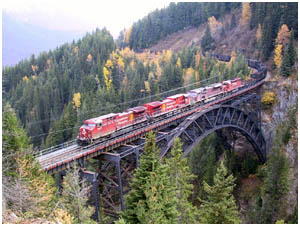
After completion of the Rogers Pass project traffic normally flows eastward on the
Connaught Track as shown by this nearly empty eastbound coal train returning to the
mine for another load in 2002.
The Shaughnessy Tunnel, the short tunnel, was closed for a brief period during 2002
for repairs. About 200 feet of lining was required near the east portal, and more
inside the west portal. This necessitated the return of pushers to handle westbound
traffic on the Connaught Track once again. The foresight of building the MacDonald
Tunnel became readily apparent once use of it was lost. Going back to single track
operation required CPR to dust off practices from the past. Crews experienced with
pusher operation became a distinct asset. Since the old pusher station no longer
existed crews were housed at Glacier Park Lodge at the summit of Rogers Pass. The
tunnel work was complete by the end of September so the pushers once again became
history.
Bibliography
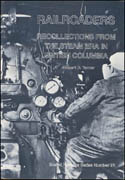 Railroaders Recollections from the
Railroaders Recollections from the
Steam Era in British Columbia
Turner, Robert D.
Provincial Archives of British Columbia 675 Belleville St. Victoria BC V8V 1X4
1981 - Soft cover
7.25 x 10.5 inches - 18.5 x 26.5 centimetres
92 pages
49 photos
2 drawings
2 maps
$3.00
Bill LaChance's personal survival story of the 1910 Rogers Pass avalance in which many perished.
 Snow War
Snow War
Woods, John G.
National & Provincial Parks Association of Canada
1985 - Soft cover
8.5 x 11 inches - 21.5 x 28 centimetres
52 pages
50 photos
0 drawings
2 maps
$6.85
Photos and captions of Rogers Pass area.
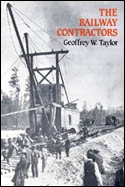 Railway Contractors, The
Railway Contractors, The
Taylor, Geoffrey W.
Morriss Publishing 1745 Blanshard St. Victoria BC
1988 - Hard cover
6.25 x 9.25 inches - 16 x 23.5 centimetres
144 pages
64 photos
0 drawings
0 maps
$17.95
Information about company that constructed the Connaught Tunnel.
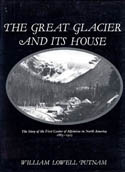 Great Glacier and its House, The
Great Glacier and its House, The
Putnam, William Lowell
American Alpine Club Inc. 113 East 90th St. New York NY USA 10028
1982 - Hard cover
9.5 x 12.25 inches - 24 x 31 centimetres
224 pages
168 photos
0 drawings
5 maps
$47.00
Oversize book. Details of the people and activity around Rogers Pass and
Glacier.
 Glacier House Rediscovered
Glacier House Rediscovered
Finch, David
Friends of Mt. Revelstoke & Glacier
1991 - Soft cover
11 x 8.5 inches - 28 x 21.5 centimetres
46 pages
33 photos
2 drawings
2 maps
$9.58
Photos and brief story about CPR's Glacier House Hotel near Illecillewaet
Glacier in the Selkirk Mountains.
Associated Links
Canadian Pacific Railway
Rogers Pass British Columbia
Glacier National Park
CP's Mountain Sub and Rogers Pass DVD
Connaught Tunnel
Canadian Avalanche
Association

|
|